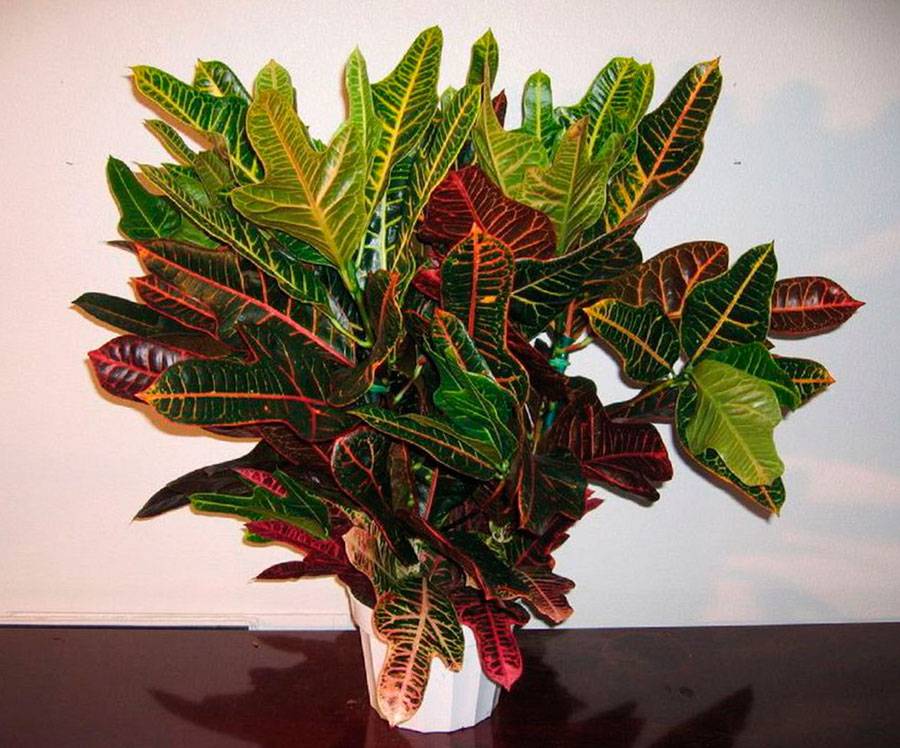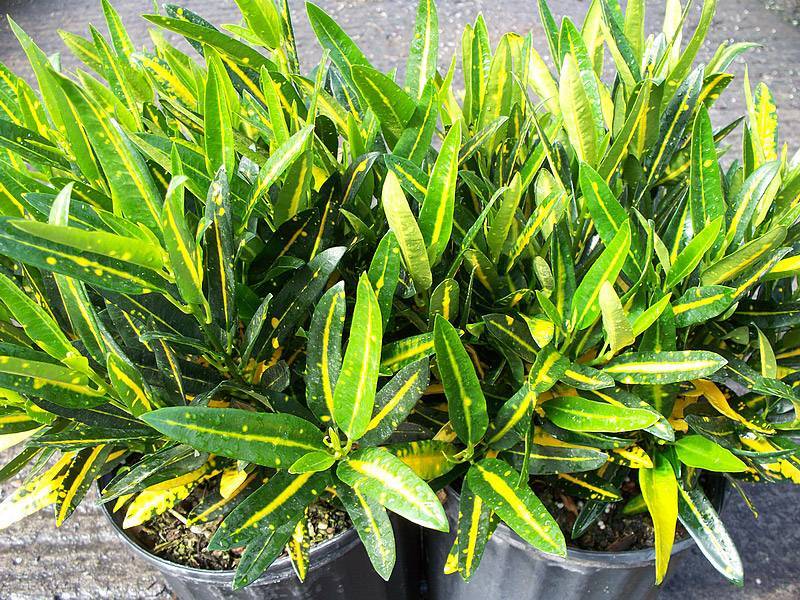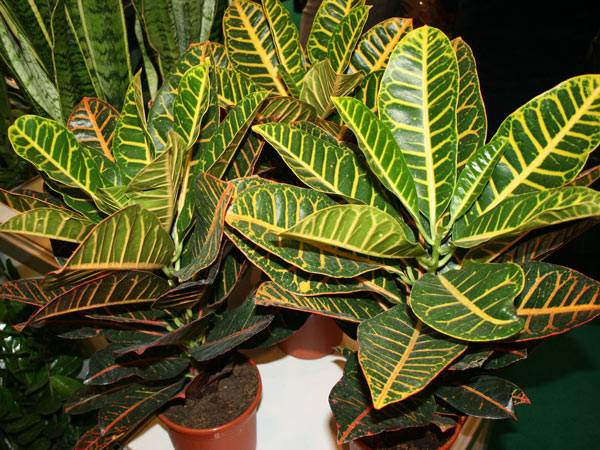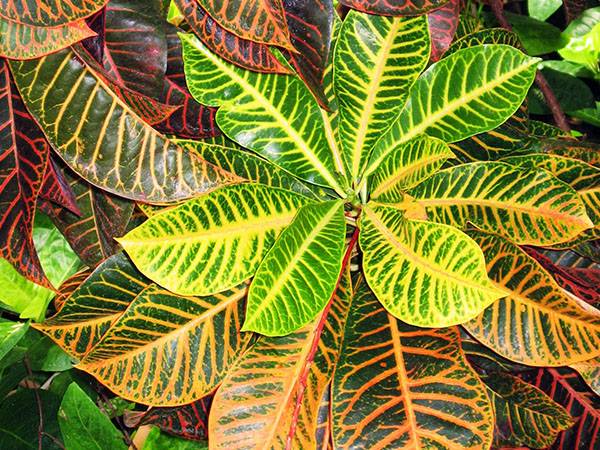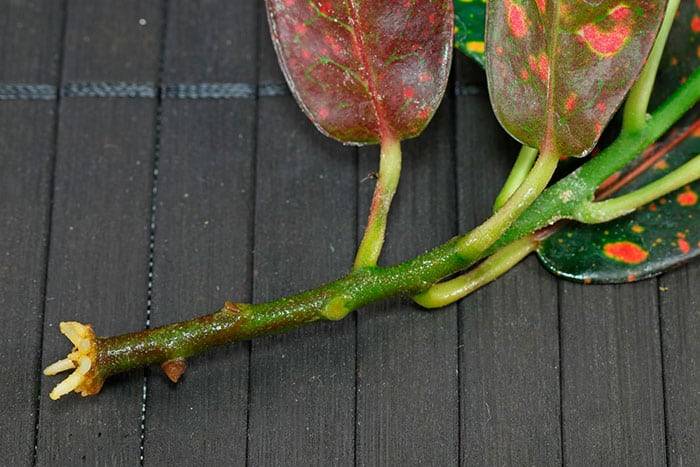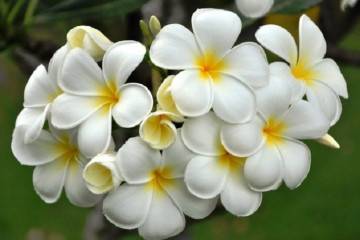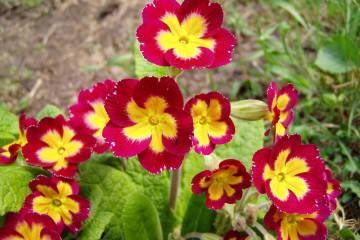Codiaum: home care and breeding methods
Content:
Codiaum, or as it is also called "cloak of Joseph", is a bright representative of the Euphorbia family. Among flower growers, this plant is often called croton. A beautiful decorative flower, it is quite problematic to grow, since it does not relate well to dry air in winter. Codiaum, home care for which is quite problematic, fits well into the interior and is able to please its owner for a long time.
Common types
Codeium, from the Euphorbia family, reaches a height of about 1.5-2 meters. The homeland of Croton is the islands in the Pacific Ocean, where it is always warm and humid. Codiaum prefers a tropical climate. There are many types of codiaum, but Croton Motley, Mammy, Sunny Star and Crispam, as well as Tamara codiae have earned the most popularity in home floriculture.
Codiaum Mummy
This species is a variety of variegated. India and Malaysia are considered the birthplace of the flower. It has the shape of a bush, the leaves of Croton Mammy are large, painted in various shades. From yellow-orange, with red blotches, to golden with green streaks.
The flower codiaum Mammy is popular among lovers of these plants, due to the unusual foliage. It is narrow, has the shape of a spiral, creating a specific curly crown.
Codiaum Variegatus Mix
This is the main species from which most forms originated. Codiaum Variegatus has large leaves, reaching 30 cm. They are characterized by leatheriness specific to codiaums. The leaves are always brightly colored with pronounced reddish or greenish veins. Each plant is individual, represents a real riot of colors - green, yellow, red, orange, and in some cases, almost black.
The description of the Varigatum Mix plant indicates that this is not a specific variety, but a whole batch of one variety. Depending on the conditions of detention and the age of the leaves, the codium flower can look completely different. Even experts are not always able to identify the croton variety in a pot labeled Variegatum Mix.
Codiaum Sunny Star
Codiaum Sunny Star is a subspecies of the plant, with a large number of shoots on the sides. The leaves are lanceolate, painted in a bright light green color, and the tips are yellow. The homeland of Sunny Star codiaum is the southeastern part of Asia, islands in the Pacific Ocean.
This is an interesting plant with narrow leaves. Codium is a flower famous for the beauty of its leaves, but it blooms inconspicuously and very rarely. Mostly in the summer. On a small peduncle, which throws out a bush, there is an inflorescence in the form of a ball. A plant similar to this variety is Croton Gold Sun.
Codiaum Crispam
Croton variety Crispam or Crispum is also called curly codeium. The flower got its name due to its narrow and curled leaves. On the green part of the leaf there are spots, stripes and streaks of various shades of yellow. These crotons also have their own varieties. A striking representative of the curly codiaum is the spiral, which has uniform curls of leaves.
Care features
Croton, grown at home, is a bush framed by leaf-shaped plates that are leathery in appearance. The shape of the sheet directly depends on the type of codiaum. It can be lanceolate, pointed, asymmetrical, curled, broadly ovate, notched, or trilobate. The leaves that have appeared recently are, in the overwhelming majority of cases, painted in a pale yellow tint. Only after a while, the color changes, turning into green and burgundy colors.
Croton is a capricious plant that requires some care. But most importantly, safety must be observed during all procedures. Protective gloves are recommended when processing the leaves, especially when transplanting by cuttings. This is due to the fact that the flower belongs to the Lesser family. Its juice is poisonous and can provoke severe disturbances from the body - nausea and subsequent vomiting, upset stools or dermatitis.
Lighting
Codiaum needs bright sunlight, but it is important to ensure that direct sunlight does not fall on its leaves. The direct sun is detrimental to Croton.
It is recommended to place the pot with the plant closer to the northern window, but in winter, it is advisable to rearrange it to the southern part. In the summer, you need to take care of the flower carefully, if possible, the croton can be taken out into the open air, choosing shaded areas with diffused light.
Air humidity
For the normal growth and development of Croton, it is important to maintain adequate indoor humidity. In addition to regularly spraying the leaves from a spray bottle, it is necessary to wet the leaves with a soft sponge. In the summer, you can shower the plant with warm water.
Watering and soil
Watering croton is a separate side in caring for a plant. It is necessary to select the irrigation regime so that the soil is always slightly damp, but at the same time do not bring the water in the pot to stagnation. Otherwise, rot may develop. It is recommended to take previously settled water. It is better if it is additionally filtered and heated water. Home care for a codium flower implies strict adherence to the water temperature. The plant cannot stand watering with cold water.
The soil
In order to plant or transplant croton, you need to use a special soil mixture consisting of peat, turf, river sand and earth. All components are taken in a 1: 1: 1: 1 ratio. It is advisable to plant a plant by transferring an earthen coma.
Fertilizers
From mid-spring to the end of autumn, it is necessary to fertilize codiaum once every 14 days. Feeding is carried out on the ground, which was previously moistened with water. Special complex fertilizers with a high mineral content are used. In winter, Croton requires soil fertilization no more than once a month.
How codiaum blooms
The codiaum blooms inconspicuously, but the peduncle takes a lot of juices from the plant. Without planning to receive seeds from the plant, you need to cut off the peduncle in a timely manner.
Codiaum: reproduction
Many gardeners are interested in how the codiaum reproduces. There are several ways to grow a flower. The fastest and most effective method is cuttings, but you can try to grow croton with seeds.
Cuttings
Propagation by cuttings is an easy and fast enough way. The apical part of the cutting is best rooted. Its length should not exceed 10 cm. Sometimes, you can get several cuttings at once. For these purposes, the escape is divided into several parts.
Cuttings with a lignified or semi-lignified covering take root well. The place where the cut was carried out must be treated with running water to remove the emitted milky juice. It is he who carries the danger and is poisonous.
After cutting, the cutting should be left in the open air for at least 3 hours. This will allow the cut site to dry out. Next, root treatment is carried out and the cutting is placed in water. The water temperature should not be less than 23 degrees to prevent the development of rot.
The stalk, which is in the water, is removed under bright lighting until the first roots appear. As soon as the length of the roots reaches a length of 2 cm, the new plant is transplanted into a container with a prepared substrate.
Once the cutting is planted in the ground, care must be taken to keep the soil moist at all times. The leaf plates regain their elasticity when the cuttings are accepted.
Sheet
Croton propagation by a leaf, in essence, is a type of cuttings. For rooting, a stem cutting is chosen, which has one leaf, an axillary bud and a part of the stem. The preparation of planting material is carried out in the same way as with cuttings. They monitor the temperature of the water in which the croton is located, humidity and light.
Seeds
You can propagate codiaum by seeds. But this is advisable only if we are talking about hybrids. Homemade croton seeds do not retain their parental properties.
To obtain the seed, you need to wait for the flowering period, wait until the flowers ripen and ovaries are formed. Only then can the seeds be collected and planted.
Croton seeds are planted in mid-winter. Before planting, the seed is disinfected. For these purposes, it is necessary to immerse the seeds in hot water for half an hour, and then keep them in water at room temperature for at least 24 hours. It is good if special growth stimulants are added to the water.
The seeds are planted in the ground under the film. The temperature in a makeshift greenhouse should be at least 25 degrees. After 30 days, you can expect the first shoots. Gradually, the sprouts begin to adapt to the surrounding conditions - they carefully water them. As soon as 2-3 true leaves are formed on the bushes, the plant can be transplanted into separate containers.
If the amateur grower is not stopped by the difficulty in growing the plant, Croton will not keep you waiting long and will certainly delight its owner with chic and unusual colors, rightfully taking its place on the windowsill.


